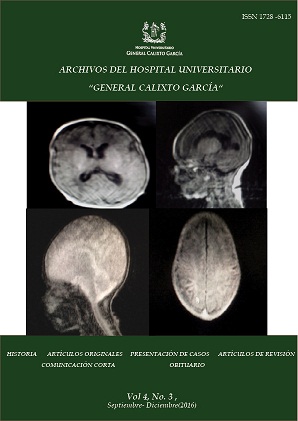First report of application of Magnetic Resonance without sedation in neonates.
Keywords:
Magnetic Resonance Image, neonate, sedationAbstract
Introduction: Magnetic Resonance Image tends to be a more progressively-accessible study for neonates, even without sedation. Aim: to highlight its utility, with no sedation in neonates, in detection and characterization of cerebral lesions with neurological damage manifestations. Method: an observational-explicative-prospective preliminary report, which included 10 neonates at Comandante ¨Manuel Piti Fajardo¨ at Obstetric and Gynecologist Teaching Hospital, between 2013- 2015 years. Initially, brain ultrasound was done. Posterior, Magnetic Resonance Image was performed. Results: 70% was reported as low weight, 60% as preterm and cesarean done. In all neonates, several lesion patterns were determined. New lesions were detected by Magnetic Resonance Image in 80% of neonates, which were not seen previously by brain ultrasound. 20% of newborns had hypoxic-ischemic encephalopathy and all of them revealed typical patterns of it, even in 10% of which no injury was diagnosed previously. Conclusions: The majorities of neonates included in this present report were preterm, low weight and delivered by cesarean. In all patients, the patterns of detection and characterization of cerebral lesions by Magnetic Resonance with no sedation were accomplished. It was shown its utility in neonates, in relation to previous brain ultrasound findings, as well as the identification of newborns hypoxic-ischemic encephalopathy
Downloads
Downloads
Published
How to Cite
Issue
Section
License
Aquellos autores/as que tengan publicaciones con esta revista, aceptan los términos siguientes:
- Los autores/as conservarán sus derechos de autor y garantizarán a la revista el derecho de primera publicación de su obra, el cuál estará simultáneamente sujeto a la Licencia Creative Commons Atribución– No Comercial 4.0 que permite el uso, distribución y reproducción no comerciales y sin restricciones en cualquier medio, siempre que sea debidamente citada la fuente primaria de publicación.
- Los autores/as podrán adoptar otros acuerdos de licencia no exclusiva de distribución de la versión de la obra publicada (p. ej.: depositarla en un archivo telemático institucional o publicarla en un volumen monográfico) siempre que se indique la publicación inicial en esta revista.
- Se permite y recomienda a los autores/as difundir su obra a través de Internet (p. ej.: en archivos telemáticos institucionales o en su página web) antes y durante el proceso de envío, lo cual puede producir intercambios interesantes y aumentar las citas de la obra publicada.









